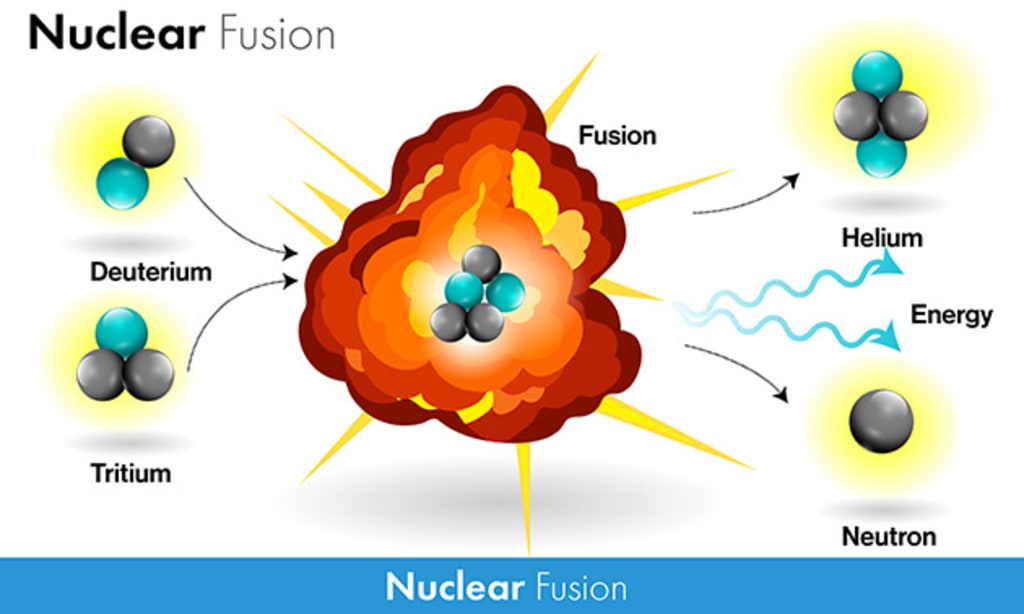Nuclear Fusion:-
It's Time to Fall in Love Again

Nuclear fusion has long been associated with delays and scams, while nuclear fission is linked to catastrophic events. Fusion, however, promises utopian possibilities, such as an endless supply of clean energy from handmade suns. These stars only require everyday hydrogen and emit helium, which is not a non-renewable resource. Fusion could also rescue the environment, decarbonize the planet, and make irrelevant all authoritarian states that derive their power from energy.
Recently, in December 2022, American scientists at the National Ignition Facility in Livermore, California, made a breakthrough in fusion by creating 100 million-degree plasma from a reaction that lasted less than 100 trillionths of a second. Although it was short-lived, the experiment produced 3.15 megajoules of energy with just 2.05 megajoules input, resulting in a 150% return on investment. The US Department of Energy aimed to use this fusion ignition to extend the lifespan of nuclear weapons. However, at least 30 private fusion companies worldwide are working on clean energy solutions based on this breakthrough. The Fusion Industry Association reports that most of these companies believe that fusion electricity will be available on the grid by the 2030s.
While the possibilities of fusion seem exciting, it is essential to approach the technology with caution. Fraudsters have already made false claims about fusion, such as electrochemists Stanley Pons and Martin Fleischmann, who declared in 1989 that they had established a sustained nuclear fusion reaction, which was quickly debunked. Despite this, faith in fusion as a source of clean energy remains high, with companies continuing to work towards making fusion a reality.
Source of clean energy. This is because the challenges involved in achieving sustained and controlled fusion reactions are immense. For one, fusion requires the hydrogen isotopes tritium and deuterium to be heated to temperatures over 100 million degrees Celsius, which is hotter than the core of the sun. To contain this plasma, strong magnetic fields are required, which in turn require the use of superconducting magnets that must operate at extremely low temperatures.
Despite these challenges, scientists and engineers have continued to work on fusion, and progress has been made. The recent breakthrough at the National Ignition Facility in Livermore, California, is a promising development, and private fusion companies are working to bring fusion energy to the grid. However, it's important to remain skeptical of fusion promises, especially when it comes to the potential for fraudsters to take advantage of the hype surrounding this technology.
In 1989, electrochemists Stanley Pons and Martin Fleischmann famously claimed to have achieved a sustained nuclear fusion reaction using garden-variety electrochemical techniques. Their claims were later debunked, and the idea of "cold fusion" came under scrutiny. It's important to remember that scientific breakthroughs require rigorous testing and peer review, and that claims of miraculous breakthroughs should be treated with caution.
while fusion energy holds great promise as a source of clean, unlimited energy, it's important to approach this technology with a healthy dose of skepticism. The challenges involved in achieving controlled fusion reactions are immense, and the potential for fraudsters to take advantage of the hype surrounding fusion should not be ignored. Nonetheless, the recent breakthrough at the National Ignition Facility and the work being done by private fusion companies are promising developments that could one day bring us closer to a world powered by clean, renewable energy.
But even with the occasional fraudster or misguided claim, the potential of nuclear fusion remains tantalizingly real. It has the potential to provide a near-limitless source of clean energy that could transform the world as we know it.
While fusion is not yet a reality on a large scale, recent breakthroughs and the growing number of private companies working on fusion technology give reason for hope. The success of the National Ignition Facility in Livermore, California, in December 2022 is just one example of the progress being made towards realizing the promise of fusion energy.
Of course, caution is always warranted when it comes to revolutionary technologies like fusion. The stakes are high, and there is always the risk of unforeseen consequences. But if we can harness the power of fusion safely and efficiently, it could truly be a game-changer for our world.
In the end, the road to fusion energy may still be long and winding, but the journey is one worth taking. We must continue to invest in research and development, encourage innovation, and support the scientists and entrepreneurs who are working to make fusion a reality. If we do, we may one day look back on this moment as the beginning of a new era in human history, powered by the clean, abundant energy of the stars.
-AR
About the Creator
Abdul Razack
Writing has been my passion. Fiction, poetry, and fanfiction are my favorite forms of storytelling. Writing movie reviews is something I enjoy doing.
Feel free to subscribe, leave a comment, and spread the love






Comments
There are no comments for this story
Be the first to respond and start the conversation.